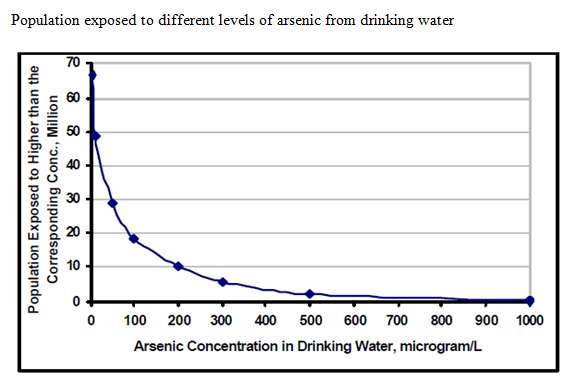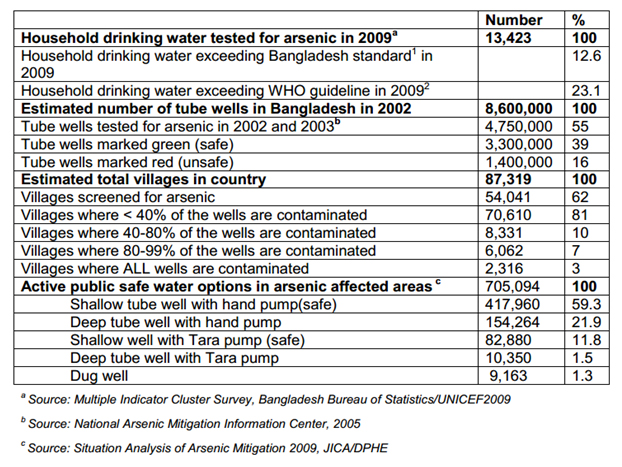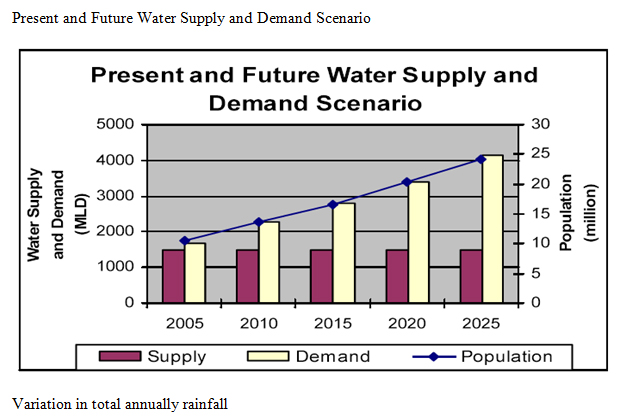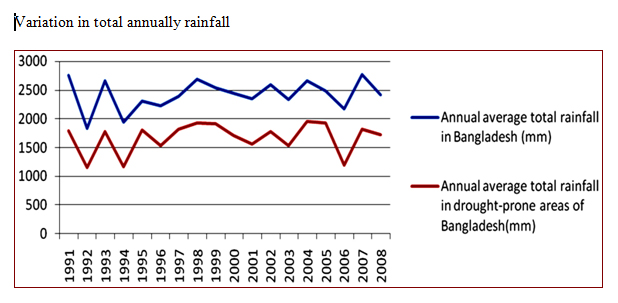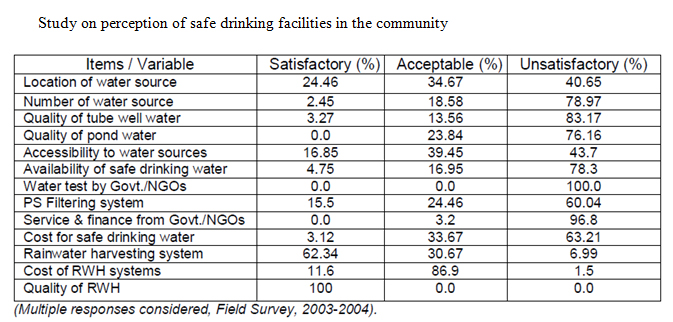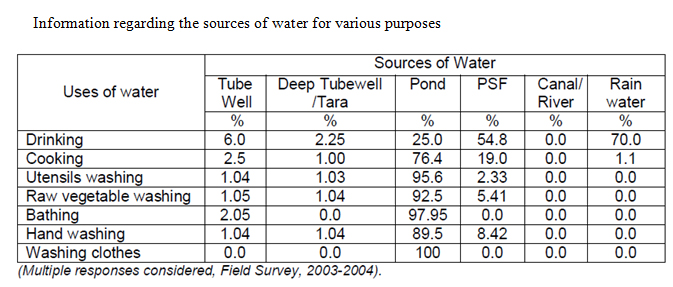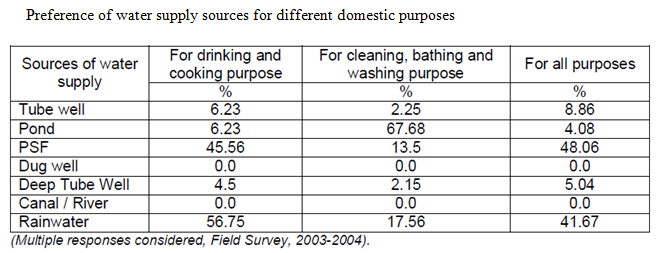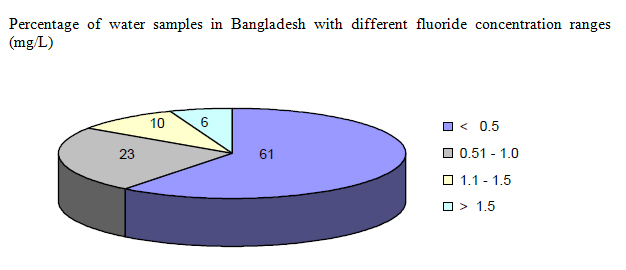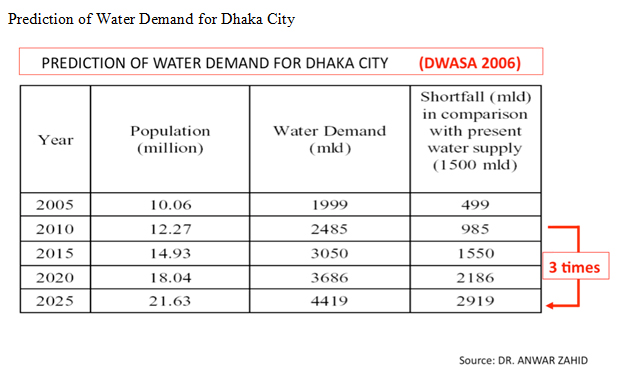Rainwater Harvesting- Bangladesh
Rainwater Harvesting- Bangladesh
Rain Water Harvesting
Rainwater harvesting is one of the feasible options of fresh water sources in the coastal areas of Bangladesh and recently a lot of initiatives and programme were undertaken to promote and install rainwater harvesting systems both in the coastal and arsenic affected areas in Bangladesh. Moreover, every year the country is also blessed with ample rain. The average annual rainfall in Bangladesh is about 2200 mm, seventy-five percent of it occurs between May and September.
Dhaka Water Supply and Sewerage Authority (WASA) have shown that rainwater is free from arsenic contamination and the physical, chemical and bacteriological characteristics of harvested rainwater represent a suitable and acceptable means of potable water. In urban areas, at a household level, rainwater can be used for flushing toilets, watering gardens and washing floor and these uses are known as non-potable. While in rural areas, it becomes the main source of water for potable uses which include drinking, bathing, and cooking.
Water resources management in Bangladesh faces immense challenge for resolving many diverse problems and issues. The most critical of these are alternating flood and water scarcity during the wet and the dry seasons, arsenic contamination, salinity, ever-expanding water needs of a growing economy and population.
According to a study by the Institute of Water Modelling based in Bangladesh’s capital city, its groundwater level is falling by three meters per year. Population has increased and industry has expanded, river water has become contaminated with industrial waste. Today, groundwater is expected to satisfy over 80% of the city’s water supply. About 150bn litres of rainwater could be harvested during the monsoon season in Dhaka city alone.
Rainwater harvesting is therefore a potential option of water supply to the coastal and arsenic affected rural communities in Bangladesh. Rainwater harvesting, low-cost systems that collect and store rainwater for year-round use, offers a cost-effective and practical solution to ease water crisis.
In a recent seminar, international NGO WaterAid and The Institute of Engineers, Bangladesh concluded that rainwater harvesting needs to be included in establishing the country’s bylaws. Therefore, In the recent years from 2000-2004, a lot of programs and huge investments have been done by government organization and NGOs with the financial support from international donor agencies to promote and install several types of household and community based rainwater harvesting systems both in the coastal and arsenic affected areas in Bangladesh as an alternative water supply sources other than groundwater. Since 1997, about 1000 rainwater harvesting systems have been installed in the country, primarily in rural areas (UNDP).
In early 2008, Coca-Cola Far East Ltd teamed up with Plan Bangladesh to install RWS in five primary schools in the Mirpur and Borguna Sadar areas of the country to ensure potable drinking water for school students.
In 2009, Coca-Cola became involved in a new partnership with UN-Habitat called The Safe Drinking Water and Sanitation Project. It is a two-year project valued at US$300,000. The goal is to impact six thousand families by demonstrating RWH and other water conservation and storage systems. RWH will be set up at twenty schools while drinking water and sanitation systems will be set up at thirty schools.
Conditions Favouring Rainwater Harvesting
Rainwater harvesting as an option can be adopted in order to facilitate availability of safe and affordable drinking water supplies and to preserve natural depressions and water bodies in major urban areas for recharge of underground aquifers.
Arsenic Contamination
Arsenic contamination of ground water affects many rural areas, whilst some urban areas including the capital, Dhaka City, lack sufficient potable ground water to meet the demand. As a result, population heavily dependent on hand pumps and tube wells are exposed to arsenic related serious health risk. World Health Organization described the arsenic contamination in Bangladesh as “the largest mass poisoning of a population in history”.
Rainwater harvesting is being considered as one of the major alternate technology with similar benefits and convenience to replace these hand pumps and tube wells.
Salinity
Bangladesh has very long coastlines and coastal area covers 20,000 square km area. In the coastal areas, aquifer conditions are not suitable for shallow tube well and high salinity in both surface and groundwater are the main constraints for the development of a dependable water supply system. Traditional rainwater harvesting for drinking purposes in a limited scale has been the common practice for long time and in some areas of the coastal region with high salinity problem. About 36 percent households have been found to practice rainwater harvesting in the rainy season for drinking purpose and domestic needs.
Fluoride Concentration
Recently there has been some concern about fluoride in drinking water in Bangladesh. In some rural areas of Bangladesh, the fluoride concentration in water is reported higher than maximum permissible limit (MPL). In rural areas, where the drinking water is drawn from available sources such as tube wells, hand pumps or ponds, in which the fluoride concentration may exceed the MPL. In order to mitigate the fluoride concentration, it is essential to treat the excess fluoride concentrated water sources or to avoid the fluoride concentrated water. The avoidance of fluoride is also likely by the use of rainwater, one of the purest forms of water without any fluoride. There are number of advantages in favour of considering rainwater harvesting as an alternate strategy.
Data:
